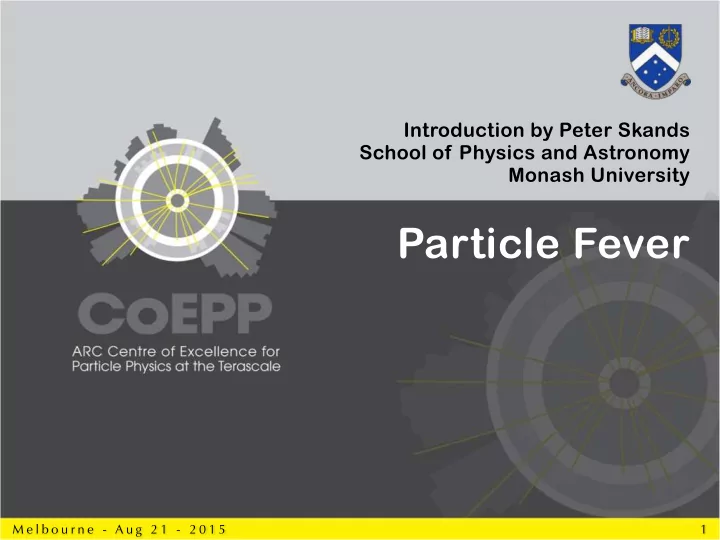

Introduction by Peter Skands School of Physics and Astronomy Monash University Particle Fever M e l b o u r n e - A u g 2 1 - 2 0 1 5 1
Fundamental Particle Physics The aim of particle physics is to study matter and force at the most fundamental level 2
Theory vs Experiment Calculations Real Data Scientific Method Real Universe Theory Model 3 P. S K A N D S
The Large Hadron Collider ๏ Monash University The LHC at CERN currently produces the highest energies we can create in lab conditions ๏ Open Day - 2015 “Stable beams” for run 2: June 3 rd , 2015 Collision Energy now: 13 Tera-eV (~ 1 million times higher than nuclear fusion) Geneva, Switzerland The Large Hadron Collider 4 P. S K A N D S
CERN: European Organization for Nuclear Research 20 European Member States and around 60 other countries ~ 10 000 scientists work at CERN. 982 134 55 979 244 280 45 108 25 16 11 7 27 Flags of CERN’s Member States Yearly budget ~ 1 billion CHF ~ 1.4 billion AUD 5 P. S K A N D S
Colliding Protons ๏ Many from One (well … from Two, really) • Quantum processes can convert the kinetic energy of the beam particles into rest energy (mass) + momentum of outgoing particles � E = energy E = mc 2 p 1 + p 2 / ( m 2 c 2 ) m = mass � p = momentum ๏ What are we really colliding? c = speed of light • Take a look at the quantum level Hadrons are composite, with time-dependent structure: d u u u p d g u 6 P. S K A N D S
Such Stuff as Beams are Made Of ๏ Lifetime of typical fluctuation ~ r p /c (=time it takes light to cross a proton) • ~ 10 -23 s; Corresponds to a frequency of ~ 500 billion THz ๏ To the LHC, that’s slow! (reaches “shutter speeds” thousands of times faster) • Planck-Einstein: E=h ν ➜ ν LHC = 13 TeV/h = 3.14 million billion THz ๏ ➜ Protons look “frozen” at moment of collision • But they have a lot more than just two “u” quarks and a “d” inside ๏ Hard to calculate, so use statistics to parametrise the structure • Every so often I will pick a gluon, every so often a quark (or antiquark) • Measured at previous colliders, as function of energy fraction ๏ Then compute the probability for all possible quark and gluon reactions and compare with experiments … OK… there’s a bit more to it, but you get the idea 7 P. S K A N D S
L H C @ h o m e 2 . 0 Te s t 4 T h e o r y - A V i r t u a l A t o m S m a s h e r p p LHC Physics Center at CERN ������������������������������������������ ��������������������������������� ����������������������������������������������������������������������������������� �������������� �������������������������� ������������� O v e r 2 0 0 0 b i l l i o n s i m u l a t e d c o l l i s i o n e v e n t s
Test4Theory - LHC@home http://lhcathome.web.cern.ch/projects/test4theory The ¡LHC@home ¡2.0 ¡project ¡Test4Theory ¡allows ¡users ¡to ¡par:cipate ¡in ¡running ¡simula:ons ¡of ¡ high-‑energy ¡par:cle ¡physics ¡using ¡their ¡home ¡computers. ¡ The ¡results ¡are ¡submiAed ¡to ¡a ¡database ¡which ¡is ¡used ¡as ¡a ¡common ¡resource ¡by ¡both ¡ experimental ¡and ¡theore:cal ¡scien:sts ¡working ¡on ¡the ¡Large ¡Hadron ¡Collider ¡at ¡CERN. New July 4 th Users/Day 2012 May June July Aug Sep 9 P. S K A N D S
Higgs Discovery Image credit: CERN 1 0 P. S K A N D S
Recommend
More recommend